#FreedomToRead2020: Alaknanda Sanap from IMLi on creating an open digital library of 100 storybooks in Kolami
Posted by Remya Padmadas on April 03, 2020
As part of StoryWeaver’s Freedom to Read 2020, the Institute for Multilingual Education (IMLi) has translated and created an open digital library of 100 storybooks in Kolami - a vulnerable indigenous language from Maharashtra. These books include bilingual Kolami-Marathi books. The digital storybooks were launched at the District Institute for Education and Teacher Training (DIET), Yavatmal on February 17, 2020, with chief guest Hon. Shri. Dipak Chavne (District Education Officer, Yavatmal) and keynote speaker, Dr. Prashant Gawande (Senior Lecturer, DIET, Yavatmal). Certificates were handed out to the educators who participated in the translation process and a reading session was conducted for Kolami children from schools in the district.
Here is an interview with Alaknanda Sanap, the founder of IMLi.
Do tell us about the IMLi - Institute of Multilingual Education, its vision, and the communities that you engage with.
The Institute for Multilingual Education (IMLi) is a registered trust working towards education and language education in India. While it has been active since 2017, it has been registered in 2018 by a group of social activists. They believe in the vision of the organization ‘to support and promote reading and multilingual education in the country with a view to promoting children's learning, engaging with community knowledge and culture and all-round development’. They believe this can be achieved through both academic pursuits such as research in language development, or through creation of multilingual books for children and through programmatic interventions such as teacher capacity building programs and advocacy.
IMLi has helped set up mini-libraries in anganwadis and school in Baramati district of Pune and trained anganwadi (pre-school) teachers on early childhood education and early literacy. They have created videos for readlongs for select books, and are in the process of creating supportive material for teachers to adopt MLE better in schools.
How did you come across StoryWeaver? What prompted you to enter into a collaboration?
IMLi had collaborated with a few organizations in Maharashtra who had translated books for tribal children and it was seen that these played a very good role in improving children's engagement with books and reading. When the Freedom to Read campaign was announced, it was felt that a similar effort could be undertaken for languages which really needed more books.
Do tell us about the Kolam community and their language. What resources are currently available? What are the challenges faced by Kolami children when they enter school?
The Kolams are a relatively small tribal group, spread across 4 states of south central India i.e. Andhra Pradesh, Chhattisgarh, Madhya Pradesh and Maharashtra. Until as recently as the 1940s, they typically practiced slash and burn farming and foraging, and were reluctant in intermingling or settling down. As such, in Maharashtra, they are part of the subcategory of particularly vulnerable tribal groups (PVTG), that are accorded more attention and support from the government for many welfare schemes. They are renowned for their familiarity with the jungle and skill in divination and the propitiation of local gods, particularly gods holding sway over forests and hills. Now, most of them are found in villages and plains where they work as tenant farmers or agricultural labourers, and a very small number of Kolams live in hill settlements. Some of them own the land they cultivate. They are scattered over a large area.
The Kolami language is part of the Dravidian language families, and as such, bears little to no resemblance with the state language of Marathi. Kolami children face a steep challenge when they enter formal centers of education such as anganwadi or school, as simple instructional words are also different.
What are the benefits of creating a local digital library of storybooks in Kolami?
If Kolami children get child-friendly reading material in addition to the syllabus, such as songs and stories, they will happily and easily familiarize themselves with Marathi letters and words. We have created and published bilingual books in Kolami-Marathi and books in Kolami on StoryWeaver.
Within Maharashtra, the Kolams are spread over three districts, and there are close to 200 primary schools with predominantly Kolami speaking children across the districts of Yavatmal, Chandrapur and Nanded, with close to 3500 children. These Kolami bilingual books can be used by teachers to support early literacy skills, and reading and writing instruction in classrooms
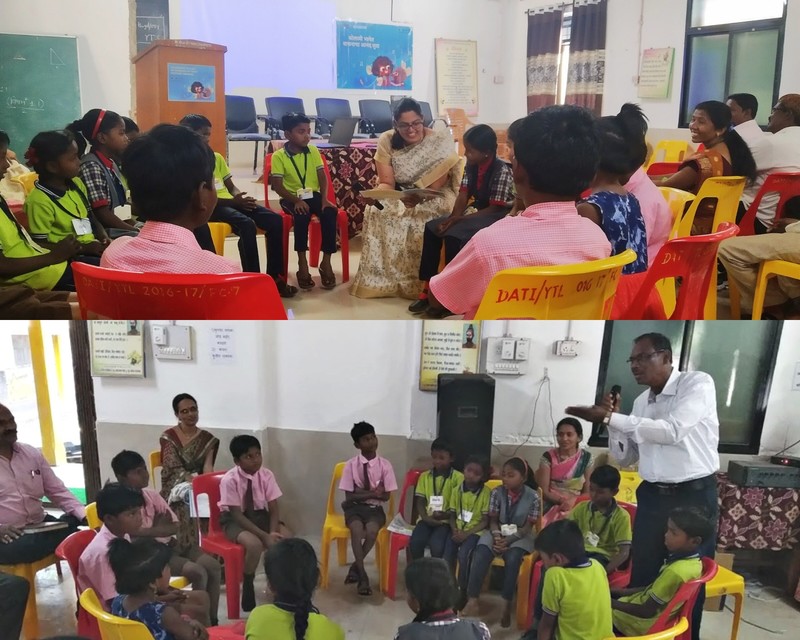
Photos from a Kolami reading session at DIET Yavatmal, held to mark the launch of an open digital library of 100 Kolami storybooks.
Tell us about the process of translation, and about the team that worked on this project.
IMLi reached out to the government teachers from the Kolam community, through the District Institute of Education and teacher training. The teachers were very happy to be part of such an initiative and enthusiastically agreed as this "was for the benefit of our children". Teachers passed on the word and referred each other and eventually 10 teachers were finalized to be part of the first workshop. While the initial plan was to translate the 100 books in phases, the enthusiastic support of the teachers made it possible to undertake the entire translation in one go, over the course of 2 workshops in a week. IMLi shared the importance of multilingual storybooks and helped the teachers understand the key points for translating for children. The workshop happened in mid September and was spread over a week.
Many of the teachers had translated the school textbooks in Kolami and had been part of other translation and literature collecting efforts in the community. Another round of review workshops was held in October when four of these senior teachers were invited to review the translations. These 2 workshops were also held across a week.
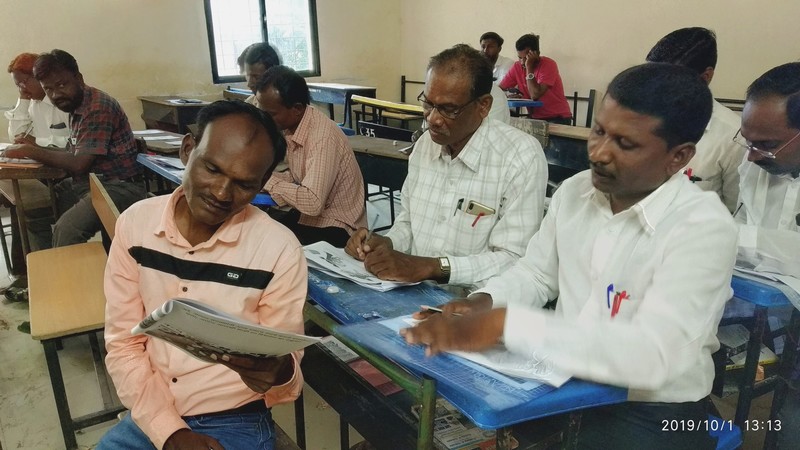
The translation team of educators at work, giving children access to storybooks in Kolami - a vulnerable indigenous language of Maharashtra.
After this, the reviewed translations were typed and first drafts of all books were prepared. After discussions, it was decided that most of the books should adopt a Marathi-Kolami layout and only a few books should be made in purely Kolami.
The draft Kolami books were then proofread with a team of volunteers who are working on a field research project on the Kolam community. Thus, after many rounds, the final books were prepared.
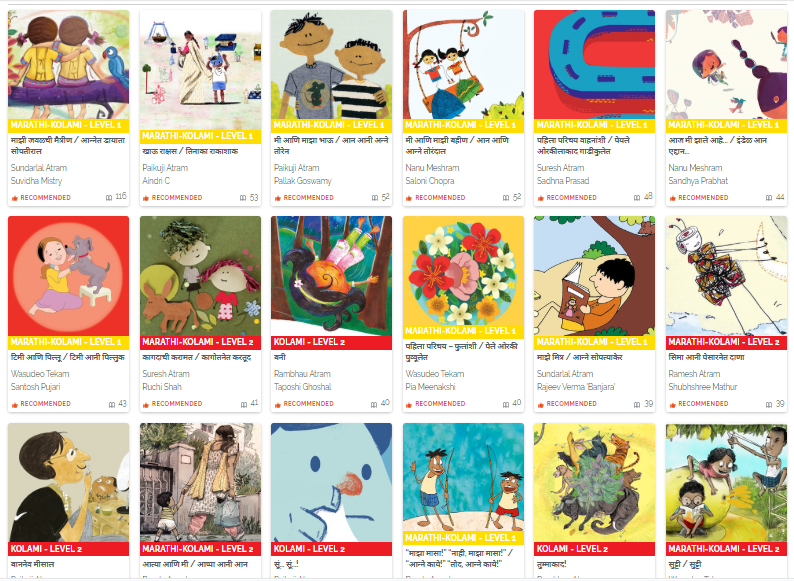
Storybooks in Kolami and Marathi-Kolami translated by Team IMLi
How do you hope to reach more children through your books in Kolami? How do you see the books being used by educators?
We plan to reach out to the Education Department and the Tribal Department to explore opportunities of collaboration. The Departments support publication and dissemination of books and story-readers for children in their respective schools. IMLi can also support the adoption of these books with teacher training sessions on pedagogy for integrating books in language learning.
Thank you so much, Alaknanda and Team IMLi, for giving children the #FreedomToRead in Kolami!
You can read the storybooks translated by IMLi here.
#TranslateAStory campaign: Translation tips and tutorials, answers to FAQs
Posted by Remya Padmadas on April 10, 2020The #TranslateAStory campaign will accelerate the creation of multilingual digital reading material, which will help children continue their learning journey at home, and give them access to books in languages they use and understand.
You can volunteer by translating a storybook (or books) on StoryWeaver. All you have to do is sign in to your StoryWeaver account and use our simple Translate tool - through this you will have access to thousands of delightful storybooks that you can translate
Here are the answers to FAQs, and the links to translation tutorials:
1. Who is eligible to participate?
Anyone who is fluent in two or more languages is urged to participate.
Individuals who are educators or translators, literacy organisations, education advocacy organisations, organisations working at the grassroots with native communities, university / college language departments or tribal departments, organisations working in language revitalization, language organisations, translation organisations, Bhasha Mandals - everyone is welcome to join the campaign.
2. Can we translate more than one book? Can we translate books into more than one language?
Yes! Every translation makes a difference.
3. I have no prior translation experience - is that okay?
It is absolutely fine if you have no prior translation experience - if you are fluent in two or more languages, you are all set!
Refer to our translation resources here, for some useful tips on the nuances of translating children’s storybooks.
4. How do I use the StoryWeaver Translate tool?
Here is a step-by-step guide on using the StoryWeaver Translate tool. You can check out our video tutorial here.
5. StoryWeaver doesn't have my language listed. Can I still participate?
Do write to us at [email protected]- we shall add your language to StoryWeaver, provided there is a Unicode compliant font for your language.
6. Is there prize money to be won?
This is not a contest, rather an invitation to volunteer our time and language expertise. There is no prize money.
7. How will I get credited for the book(s) I translate?
Once you create your own, individual account on StoryWeaver, this ensures that you receive an attribution for your translation.
8. There are 4 reading levels - what does this mean? Does it make a difference to the translation?
It is always good to keep the reading level of the child in mind while translating a storybook. Use the ‘filter by level’ option on the Translate page to browse and choose a book.
- Level 1: Storybooks for beginner readers. These books usually have short, simple sentences and don't have more than 1-2 sentences per page.
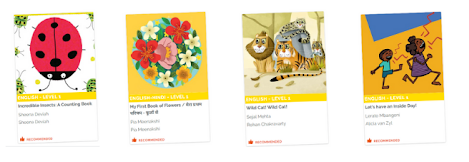
- Level 2: Storybooks for those who are learning to read, based on simple concepts. The books have short sentences and there are not more than 3-4 sentences per page. However you will find that some big but common words are used in these books.
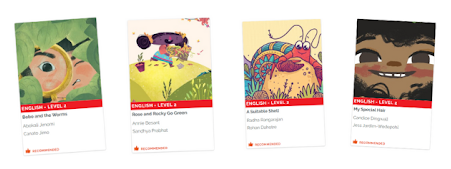
-
Level 3: Storybooks for independent readers which have popular topics with well sketched out characters. The books have longer sentences, paragraphs and complex words.
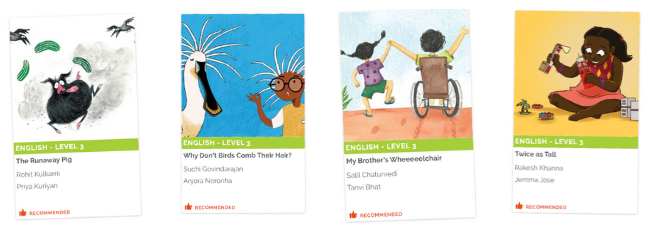
-
Level 4: These stories are meant for those who can read proficiently and have nuanced storylines. The books have complex words, longer sentences and paragraphs. These stories sometimes contain language play like idioms, metaphors, similes, etc. Also words from other languages are introduced.
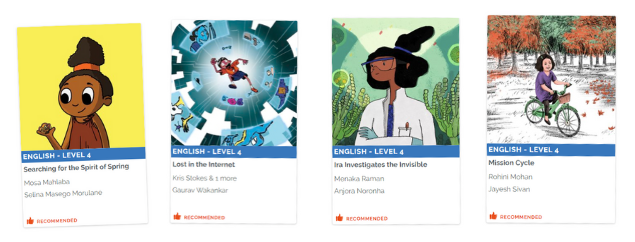
We hope this helps!
Looking for some inspiration for which storybooks to translate? Start here.
By submitting your translation to StoryWeaver, you are agreeing to a CC-BY 4.0 license being applied to it. Terms and conditions apply. For more read here.
For any other queries, do write to us at [email protected]
StoryWeaver Spotlight: Gireesh
Posted by Pallavi Kamath on April 07, 2020Gireesh is a writer, visual artist and translator from Chennai. A fine arts graduate, his book was published last year in Tamil and an English translation is under progress. He has translated many storybooks on StoryWeaver including Friends Under the Summer Sun and Who Stole Bhaiya's Smile?
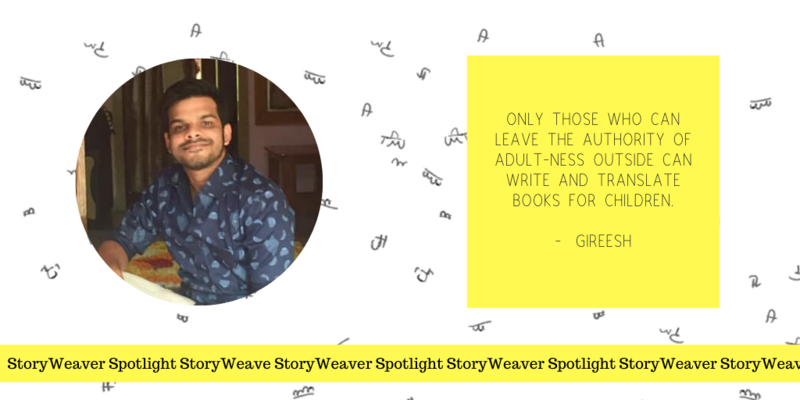
Q: Can you tell us anything about yourself and your job that would surprise us?
நான் ஓவியக்கல்லூரியில் படித்து விளம்பரத்துறையில் வேலை செய்கிறேன். விடுபட்டவை எனும் புத்தகமும் எழுதி இருக்கிறேன். பத்திரிக்கைகளுக்கு கட்டுரைகளும் கதைகளும் எழுதும் பழக்கமுண்டு.
I am an arts graduate from the Fine Arts college, working now in advertising. I have written a book called Vidupattavai, among other stories and articles.
Q: What is your personal relationship to language and/or translation?
எனக்கு புத்தகங்கள் வாசிப்பது மிகவும் பிடிக்கும். வாசிப்பதன் மூலமாக புதிது புதிதான வார்த்தைகளையும் சொல்லாடல்களையும் கண்டுகொள்ள முடிகிறது.
I love reading. I find new words and expression through reading.
Q: When you have been given a story to translate, what is your process, and how long does it usually take?
முதலில் அந்த கதையை முழுவதுமாக வாசிப்பேன். மொழிபெயர்ப்பதற்கு முன்னால் அந்தக் கதையை மனதிற்குள் பலமுறை தமிழில் சொல்லிப்பார்ப்பேன். பின்னர் அதை மொழிபெயர்ப்பு செய்வேன். மொழிபெயர்க்க இரண்டு முதல் மூன்று மணிநேரங்கள் எடுத்தாலும் குறிப்பிட்ட இடைவெளியில் அதை வாசிப்பேன். தேவைப்படும் மாற்றங்கள் செய்வேன். வாசிக்கும்போது கடினமாக இருக்கும் வார்த்தைகளையும், பெரிய பெரிய வாக்கியங்களையும் கூடுதல் கவனத்தோடு மாற்றுவேன்.
I read a story and tell it to myself in Tamil a few times. I spend a few hours translating it, and I read it a couple of times at regular intervals to make changes. When I feel certain words or sentences are hard, I change them with extra care.
Q: How did you cultivate the skills needed to translate books for children?
குழந்தைகளுக்கான புத்தகங்களை மொழிபெயர்க்க தொடங்கியபிறகு நிறைய குழந்தைகள் புத்தகம் வாசிக்கிறேன். பெரும்பாலான புத்தகங்கள் பெரியவர்கள் மொழியிலேயே இருப்பதால் வார்த்தைகளுக்கான மாற்று வார்த்தைகளைத் தேடிக் கண்டுபிடிக்கிறேன். எளிதான வார்த்தைப் பதங்களை தொடர் வாசிப்பில் இருந்தே பெற முடிகிறது.
I've read a lot of children's books since I started translating books for kids. Since most books are for adults, I look for alternative words for words. You can get easy word phrases from a series of readings.
Q: What was the experience of translating a children’s book like, compared to translating/writing for adults?
பெரியவராக இருப்பதால் பெரியவர்களின் மொழி புரிந்து விடுகிறது. ஆனால் குழந்தைகளின் மொழியைப் புரிந்து அவர்களுக்கான மொழிபெயர்ப்பு செய்வது என்பது சவாலாகவே இருக்கிறது. சமயங்களில் இது குழந்தைகளுக்கு புரியாது என இன்னும் எளிமைப்படுத்தும் விதத்தில் எழுத முயற்சிக்கும் வார்த்தைகள் குழந்தைகள் ஏற்கனவே அறிந்து வைத்திருப்பது ஆச்சரியமாக இருக்கிறது. மேலும் குழந்தைகள் புத்தகம் என்றாலும் நான்கு நிலைகளில் உள்ள குழந்தைகளிடம் கொண்டு சேர்ப்பதும் சவாலான வேலையே.
As an adult it is easy to understand adults’ language. But to understand and translate in a child's language is hard. Sometimes when I try to simplify words thinking it might not be understood by children, it was surprising to know children already knew those words. It is also challenging to work across four different levels.
Q: You have translated more than a few books for us now. Which is your favorite among them and why?
நான் மொழிபெயர்ப்பு செய்த கதைகளில் எனக்கு மிகவும் பிடித்தது கோடைகால நண்பர்கள். குழந்தைகளிடம் பாலினம் குறித்த மிகத்தேவையான உரையாடலையும், சகமனிதர்களை அவர்களாகவே ஏற்றுக்கொள்ள வேண்டும் என்கிற கருத்தையும் அந்தக் கதை கூறியதால் எனக்கு அது பிடித்திருந்தது.
Friends Under the Summer Sun was my favorite. As it starts the necessary discussion about gender, and tells every kid to accept others as they are, I like it.

Q: What is the hardest thing about translating from English into Tamil? How do you navigate words or phrases that are tricky to translate?
பெயர்களையும் ஊரையும் மொழிபெயர்ப்பில் கொண்டுவருவதே சிரமமாக இருக்கும். சில சமயம் ஒரு நல்ல கதையை மொழி பெயர்க்கும்போது நம்மால் பொருத்திப்பார்க்க முடியாத பெயர்கள் இருக்கும்போது அவற்றுடன் தொடர்புபடுத்த முடியாது. அம்மாதிரியான சமயங்களில் வாய்ப்பிருந்தால் அர்த்தம் மாறாத மற்றும் தொடர்புபடுத்தக் கூடிய பெயர்களை உபயோகிக்கிறேன். பின்னர் உணர்வுகளை வெளிப்படுத்த பயன்படும் எந்த பொருளும் இல்லாத சத்தங்களும் கடினமே. அவற்றிற்கு இணையாக தமிழில் பயன்படுத்தப்படும் சத்தங்களை அந்த இடத்தில் பயன்படுத்துகிறேன்.
It is hard sometimes to capture names of persons and places. In such situations, I make them sound more relatable. Onomatopoeia is always a challenge, I try not to transliterate and use sounds more relatable to Tamil readers.
Q: What type of person do you think makes the best translator for children’s stories?
குழந்தைகள் உலகத்துக்குள் பெரியவர்கள் எனும் அடையாளத்தோடும், அதிகாரத்தோடும் நுழையாத ஒருவரால் மட்டுமே குழந்தைகளுக்கான புத்தகத்தை எழுதவும் மொழிபெயர்க்கவும் முடியும்.
Only those who can leave the authority of adult-ness outside can write and translate books for children.
Q: Do you have any advice for anyone interested in becoming a translator?
நமது திறமையையோ நமது மொழிப்புலமையையோ குழந்தைகளுக்கு நிரூபிப்பது நமது வேலையல்ல. ஏற்கனவே எழுதப்பட்ட புத்தகத்தை சுவையும் கருத்தும் மாறாமல் எளிமையாக நமது மொழியில் மாற்றிக் கடத்துவது மட்டுமே நமது வேலை என்பதைப் புரிந்துகொள்பவராலேயே ஒரு நல்ல மொழிபெயர்ப்பை செய்ய முடியும்.
We are not trying to impress children with our talent and language skills. We only transfer a book with the same feel and simplicity. One can be a good translator when one understands this.
You can read all the books translated by Gireesh here.
Do join the conversation by leaving your thoughts in the comments section below. You can also reach out to us through our social media channels: Facebook, Twitter and Instagram.
comment (1)